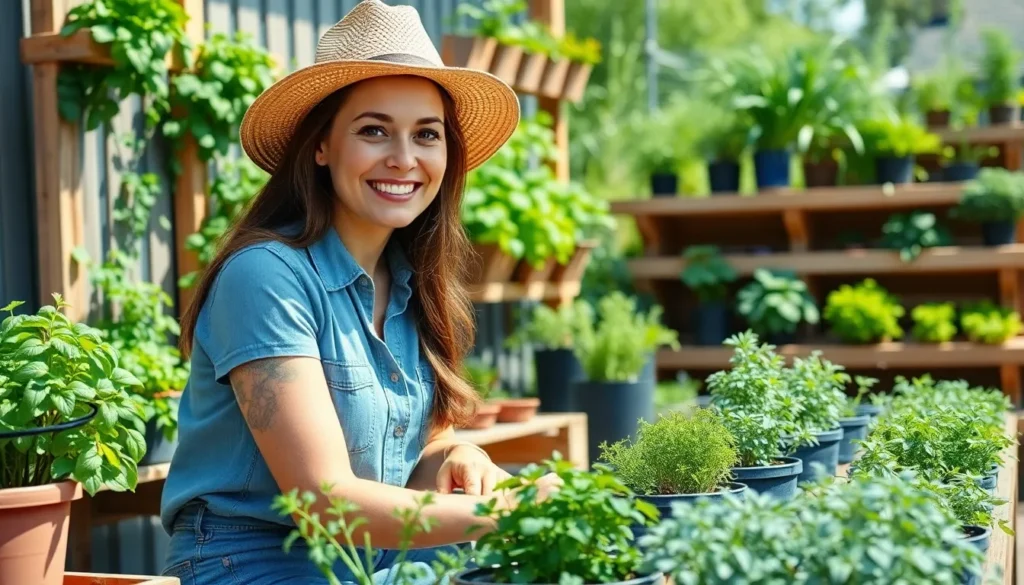We’ve all dreamed of stepping into our backyard and harvesting fresh herbs for tonight’s dinner or plucking ripe tomatoes straight from the vine. A kitchen garden transforms this dream into reality while revolutionizing how we think about food and cooking. These purposeful spaces bring incredible flavor and nutrition directly to our tables.
Creating a thriving kitchen garden doesn’t require acres of land or years of gardening experience. We can design productive growing spaces in containers on apartment balconies or transform small yard corners into abundant food sources. The key lies in choosing the right plants and understanding simple growing principles.
The benefits extend far beyond fresh produce. We’ll save money on groceries while reducing our environmental impact and connecting with nature’s rhythms. From aromatic basil that elevates our pasta dishes to crisp lettuce for daily salads our kitchen garden becomes an extension of our culinary creativity and sustainable lifestyle.
Start With Easy-to-Grow Herbs for Your Kitchen Garden
Herbs represent the perfect starting point for our kitchen garden journey. Most varieties thrive in small spaces and forgive beginner mistakes while delivering incredible flavors to our daily cooking.
Choose Low-Maintenance Options Like Basil and Parsley
Basil stands out as one of the most rewarding herbs we can grow at home. This aromatic plant produces abundant leaves throughout the growing season and requires only basic watering and sunlight. Sweet basil varieties like Genovese work perfectly for pasta dishes and pesto, while Thai basil adds an exotic twist to Asian cuisine.
Parsley offers another foolproof option for new gardeners. Both flat-leaf and curly varieties grow reliably in containers or garden beds with minimal care. We can harvest parsley continuously by cutting outer stems first, allowing the center to keep producing fresh growth. This versatile herb enhances everything from soups to salads while providing vitamin C and antioxidants.
Cilantro grows quickly from seed and tolerates cooler weather better than many herbs. We can succession plant cilantro every two weeks for a continuous harvest since it tends to bolt in hot weather. Fresh cilantro transforms Mexican dishes, Asian cuisine, and homemade salsas with its distinctive flavor.
Chives produce edible flowers along with their grass-like leaves, making them both functional and decorative. These hardy herbs require virtually no maintenance once established and provide a mild onion flavor perfect for garnishing soups, eggs, and baked potatoes.
Consider Perennial Herbs Such as Rosemary and Thyme
Rosemary serves as a long-term investment in our kitchen garden since this woody perennial can live for decades with proper care. Mediterranean climates suit rosemary best, but we can grow it in containers and bring it indoors during harsh winters. The needle-like leaves retain their potency when dried, making rosemary excellent for roasted meats, potatoes, and bread recipes.
Thyme creates a low-growing carpet of tiny aromatic leaves that release intense fragrance when brushed. This drought-tolerant herb thrives in poor soil conditions where other plants struggle. We can choose from many thyme varieties including lemon thyme for seafood dishes and French thyme for traditional European cooking.
Oregano spreads naturally through underground runners, eventually forming dense patches of flavorful leaves. Wild oregano typically offers stronger flavor than common varieties, making it ideal for pizza sauces and Italian dishes. We should trim oregano flowers regularly to maintain leaf production and prevent excessive spreading.
Sage produces silvery-green leaves with a distinctive earthy flavor that complements poultry and pork dishes. This drought-resistant perennial requires minimal water once established and can withstand freezing temperatures in most climates. Purple sage and golden sage varieties add ornamental value while providing the same culinary benefits as common sage.
Design Compact Vertical Growing Solutions
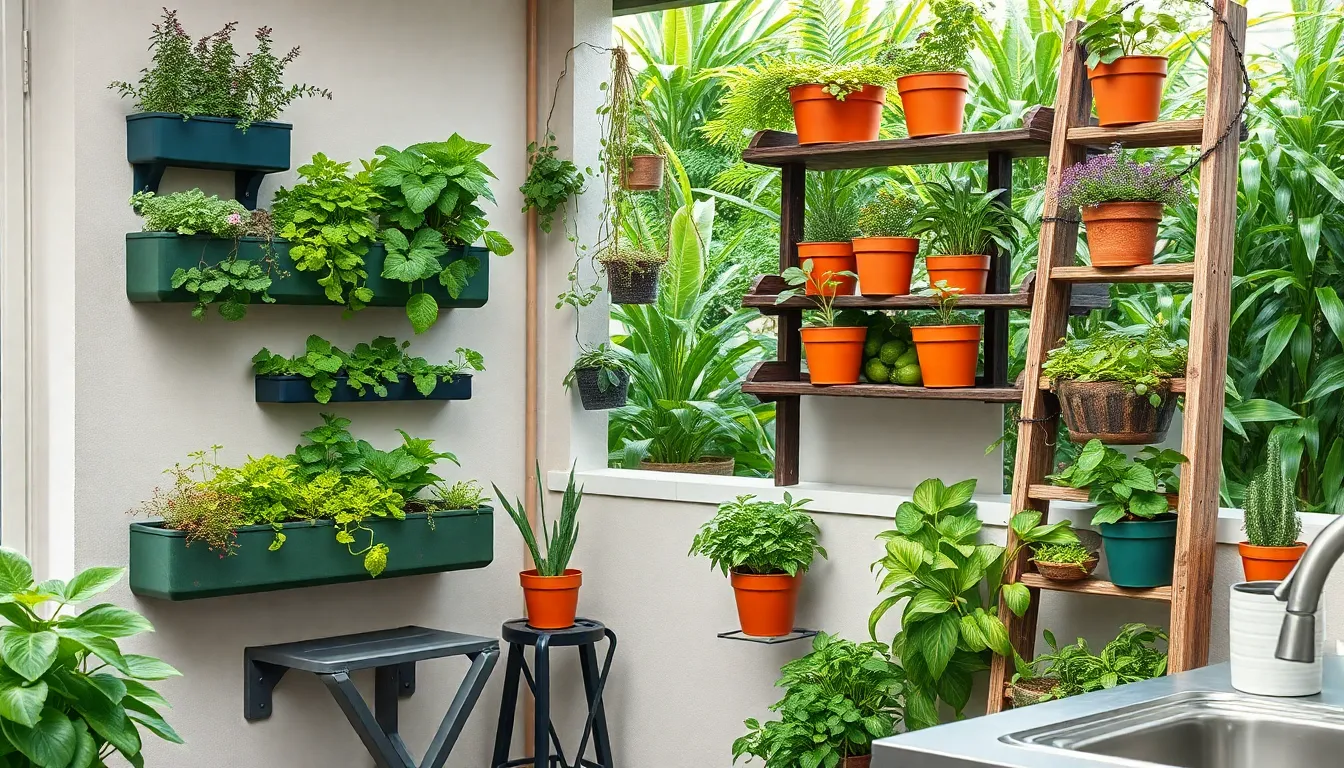
Maximizing garden space becomes essential when working with limited kitchen areas. Vertical growing answers allow us to transform even the smallest spaces into productive herb and vegetable gardens.
Install Wall-Mounted Planters for Small Spaces
Wall-mounted planter boxes offer the perfect solution for growing herbs and vegetables directly on vertical surfaces. We can customize these planters to fit different spaces and styles while maintaining easy access for daily harvesting and maintenance.
Living walls create stunning visual impact using modular planter systems that attach securely to walls. These systems provide a lush green appearance while maximizing our growing space through vertical stacking of multiple plant varieties.
Window boxes with trellises combine growing space with climbing support for plants like peas, beans, or cucumbers. This dual-purpose approach maximizes space efficiency while adding aesthetic value to our kitchen garden design.
Create Tiered Garden Beds Using Shelving Systems
Multi-tiered container gardens use stacked containers of varying sizes to create effective growing levels. This setup works exceptionally well for growing tomatoes and herbs while ensuring proper drainage through multiple container layers.
Ladder shelving systems repurpose old ladders by leaning them against walls and attaching planters to each rung. We can use hooks and small containers on different ladder levels while providing trellis support for climbing vegetables.
Hanging shoe storage bags transform into compact vertical gardens when each pocket holds small plants. This creative solution works perfectly for herbs or small vegetables while utilizing minimal floor space in our kitchen garden area.
Wood pallet gardens repurpose shipping pallets by attaching small planters or growing bags to the pallet slats. We can mount these vertically against walls or fences to accommodate multiple plants in concentrated growing areas.
Select Fast-Growing Vegetables for Quick Harvests
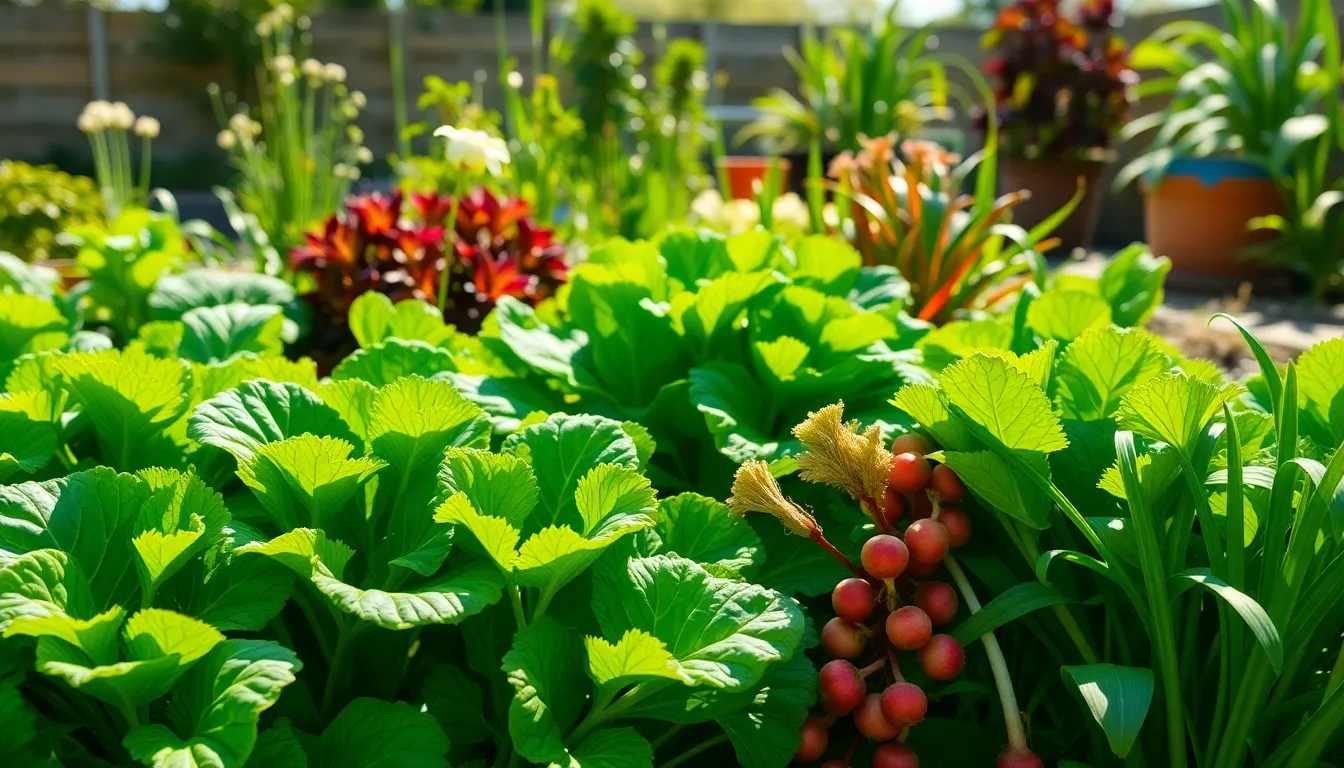
Building on our vertical growing answers, we can maximize our kitchen garden’s productivity by choosing vegetables that deliver quick results. Fast-growing varieties ensure we’ll have fresh produce on our table within weeks rather than months.
Plant Leafy Greens Like Lettuce and Spinach
Lettuce varieties provide us with fresh salad ingredients in just 45-50 days from seed to harvest. We can choose from butterhead, romaine, or leaf lettuce depending on our taste preferences and growing conditions. These greens thrive in cooler temperatures, making them perfect for spring and fall planting in most regions.
Spinach delivers even faster results, with varieties like Bloomsdale ready for harvest in just 20-30 days. We’ll find spinach incredibly versatile, working well in salads, smoothies, and cooked dishes. Both lettuce and spinach grow well in containers, making them ideal choices for our vertical growing systems or window boxes.
Temperature management becomes crucial for these leafy greens since they prefer cooler conditions. We can extend our growing season by providing afternoon shade during hot summer months or using cold frames during cooler periods.
Grow Radishes and Green Onions for Rapid Results
Radishes stand out as one of our fastest-growing options, ready for harvest in just 21-30 days from planting. We’ll enjoy their peppery bite in salads, and they’re particularly forgiving for beginning gardeners. Container growing works perfectly for radishes, requiring only 6 inches of soil depth.
Green onions deliver fresh flavor to our dishes in approximately 20-30 days when grown directly in the ground. We can harvest them continuously by cutting the green tops while leaving the roots intact for regrowth. Their compact size makes them excellent companions for other vegetables in our garden beds.
Both vegetables require minimal space and care, making them perfect starter crops for new kitchen gardeners. We can succession plant these varieties every 2-3 weeks to ensure a continuous harvest throughout the growing season.
Incorporate Container Gardening for Flexibility
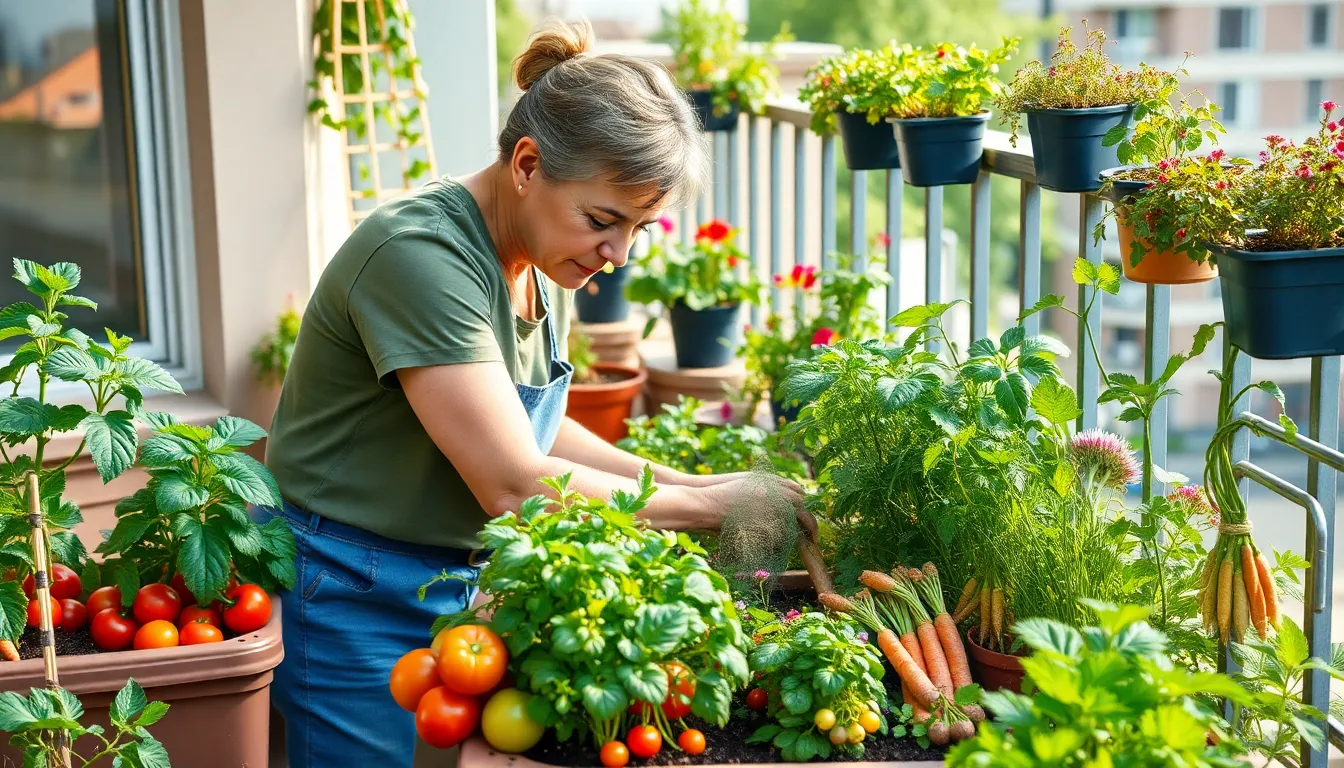
Container gardening offers unlimited flexibility for kitchen gardens while maximizing growing potential in any space. We can easily arrange and rearrange potted plants to optimize sunlight exposure and create the perfect growing environment.
Use Large Pots for Tomatoes and Peppers
Tomatoes require substantial root space to produce abundant harvests throughout the growing season. We recommend selecting containers with at least 5-gallon capacity to accommodate their extensive root systems. Deep pots provide the necessary support for tall varieties like indeterminate tomatoes that can reach 6-8 feet in height.
Peppers thrive in similarly sized containers that offer adequate drainage and root development space. Large pots allow pepper plants to establish strong root networks that support heavy fruit production. We’ve found that deeper containers prevent plants from becoming root-bound and maintain consistent moisture levels.
Both crops benefit from containers that are at least 12-18 inches deep and equally wide. This size ensures proper root expansion while providing stability for mature plants loaded with fruit. Well-draining containers prevent waterlogged soil that can lead to root rot and reduced yields.
Choose Shallow Containers for Root Vegetables
Carrots and beets need containers that are 6-8 inches deep to accommodate their taproot development. We can successfully grow these root vegetables in rectangular planters or deep window boxes that provide sufficient soil depth. Shorter carrot varieties like Paris Market perform exceptionally well in containers with this depth requirement.
Radishes flourish in shallow containers measuring just 4-6 inches deep due to their compact root structure. These quick-growing vegetables mature in 21-30 days and don’t require extensive soil depth. We can plant radishes in wide, shallow containers to maximize the number of plants per pot.
Root vegetables in containers offer easier harvesting and better soil control than traditional garden beds. Container growing allows us to provide the loose, well-draining soil that root crops prefer while preventing competition from weeds. We can also move containers to optimize growing conditions throughout the season.
Plan Seasonal Succession Planting Strategies
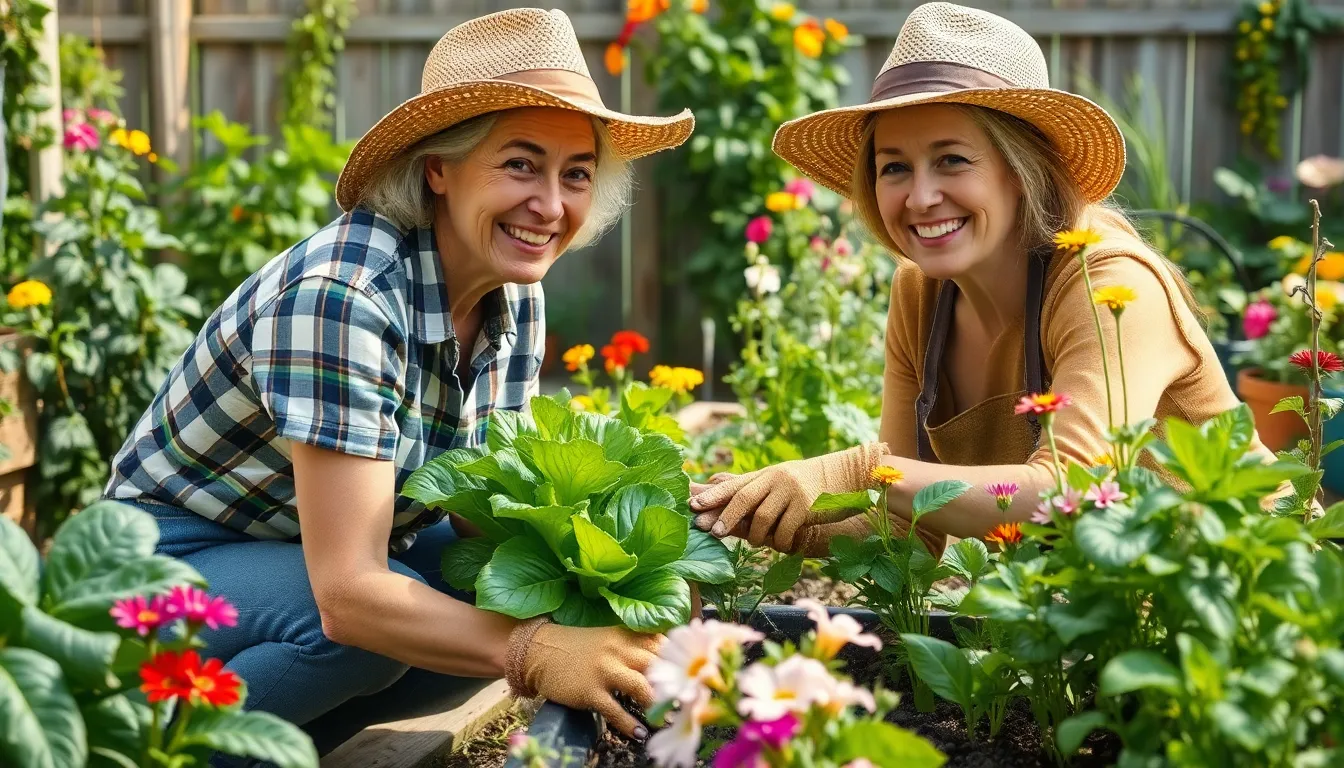
Building on our container gardening foundation, we’ll explore how strategic timing transforms our kitchen garden into a continuous harvest powerhouse. Planning seasonal succession ensures we’re never without fresh produce throughout the growing season.
Stagger Plantings for Continuous Harvests
Plant the same crops every two weeks to maintain a steady supply of fresh vegetables rather than overwhelming harvests all at once. Leafy greens like lettuce, arugula, and spinach work perfectly for this strategy since they mature quickly and can be harvested frequently.
Position fast-growing crops near garden edges or pathways for easy access during frequent replanting sessions. We’ll harvest outer leaves while inner portions continue growing, extending each plant’s productive period.
Track planting dates using a garden calendar to schedule the next round of seeds before current crops finish producing. This prevents gaps in our fresh vegetable supply and maximizes garden productivity throughout the season.
Companion plant herbs and flowers alongside our staggered greens to protect them from pests while improving overall garden productivity. Basil planted near lettuce deters harmful insects while providing aromatic herbs for our kitchen.
Rotate Cool and Warm Season Crops
Cool season crops thrive in spring and fall temperatures between 60-70°F, making spinach, lettuce, peas, and carrots ideal for early spring planting. These vegetables can tolerate light frosts and actually prefer cooler weather for optimal growth.
Warm season crops require full summer heat above 70°F and include tomatoes, peppers, beans, and summer squash that we plant after our last frost date. These heat-loving plants need consistent warmth to develop properly and produce abundant harvests.
Replace spring cool season crops with warm season varieties as temperatures rise in late spring, then transition back to cool season plantings for fall harvests. This rotation strategy keeps our garden beds continuously productive while maintaining soil fertility.
Alternate crop families in the same garden beds to prevent pest and disease buildup while naturally replenishing soil nutrients. Following heavy feeding warm season crops like tomatoes with nitrogen fixing cool season peas creates a natural fertilization cycle.
Maximize Space With Companion Planting Techniques
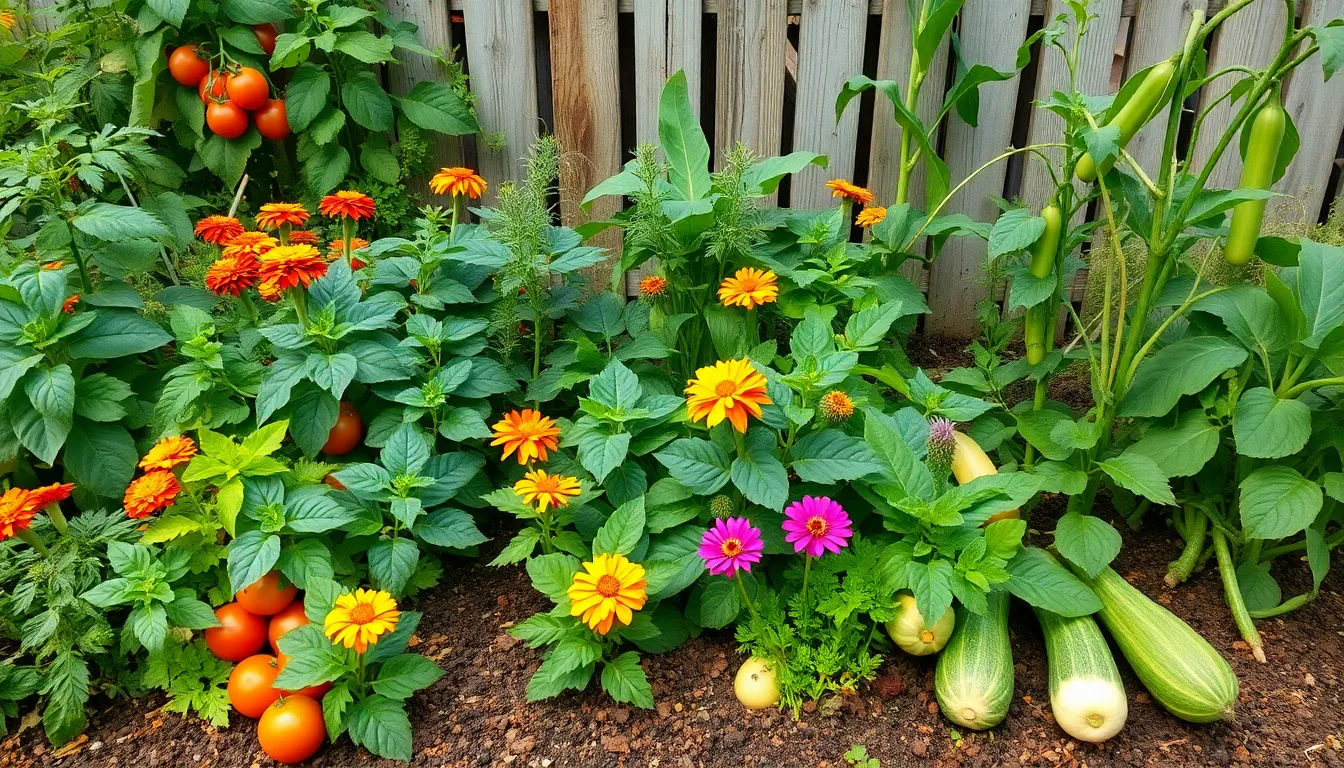
Companion planting transforms our kitchen gardens into efficient growing systems that maximize productivity within limited space. These strategic partnerships between plants create natural synergies that boost growth while reducing pest problems.
Pair Complementary Plants for Better Growth
Pairing plants with complementary growth habits creates mutually beneficial relationships that optimize our garden space. Basil serves as an excellent companion for tomatoes by repelling pests that commonly target tomato plants while taking up minimal ground space beneath the larger plants. Marigolds add vibrant color to our garden borders while deterring harmful nematodes that can damage vegetable roots.
Strategic interplanting allows us to combine fast growing crops with slower developing plants for maximum efficiency. Radishes mature quickly between rows of carrots, providing an early harvest while the carrots continue developing underground. Leaf lettuce thrives in the partial shade created by taller tomato plants, extending our growing season and preventing bolt during hot weather.
Vertical companions maximize our growing space by utilizing different plant heights effectively. Pole beans climb corn stalks naturally, eliminating the need for separate trellises while fixing nitrogen in the soil. Cucumbers trained up cages or stakes produce abundant fruit in minimal horizontal space, leaving ground level available for compact herbs like oregano and thyme.
Use Three Sisters Planting Method
Three Sisters planting creates a traditional space saving system that combines corn, beans, and squash in one productive area. Corn stalks provide natural climbing structures for bean vines, eliminating the need for additional support systems while maximizing vertical growing space. Beans contribute nitrogen fixation that benefits both corn and squash plants throughout the growing season.
Squash plants spread horizontally to create living mulch that suppresses weeds and retains soil moisture. This ground covering effect reduces our maintenance time while conserving water resources during dry periods. The large squash leaves also provide natural pest deterrent by creating habitat for beneficial insects that protect all three crops.
Planning our Three Sisters garden requires spacing corn plants 12 inches apart in clusters rather than rows. We plant beans around each corn stalk once the corn reaches 6 inches tall, then add squash seeds at the edges of each cluster. This arrangement produces maximum yield from minimal garden space while creating a visually appealing growing area that requires less weeding and watering than traditional single crop rows.
Create Dedicated Sections for Different Plant Types
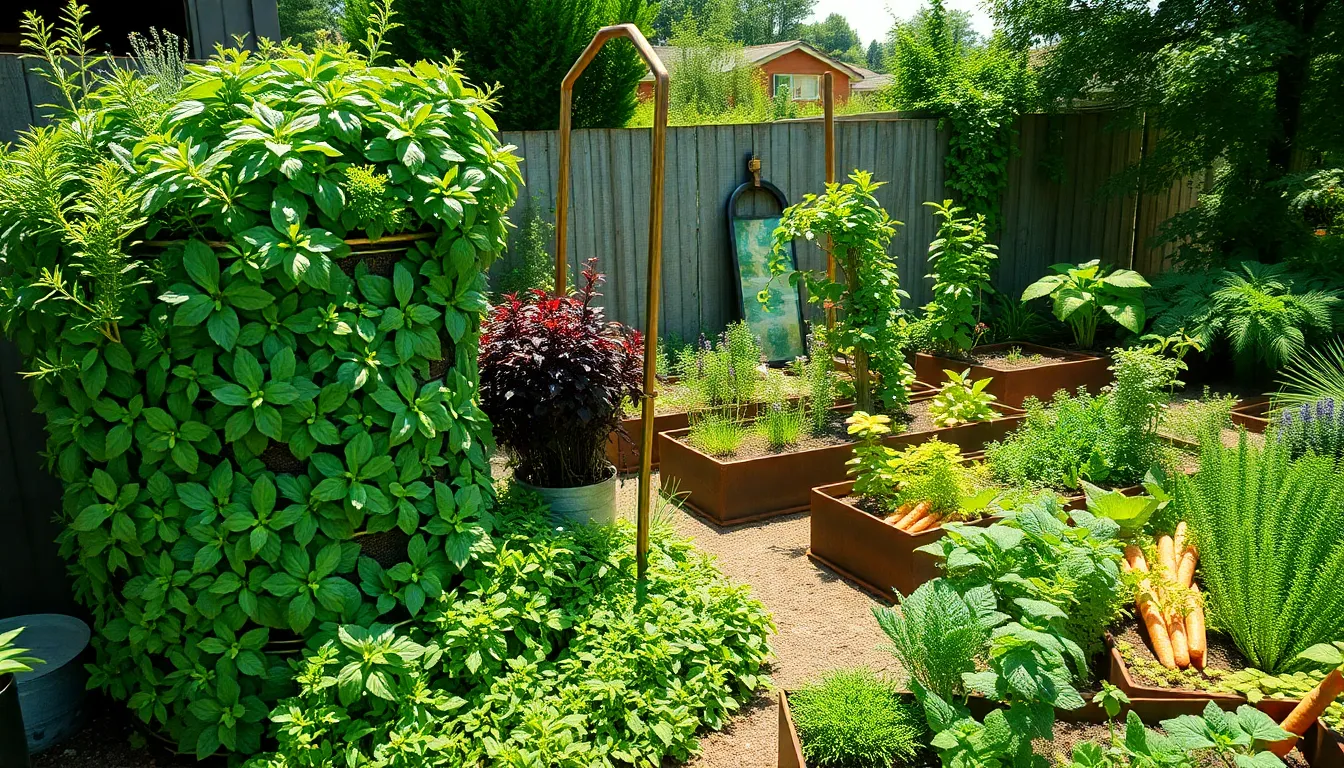
Organizing your kitchen garden into exact zones maximizes growing success and simplifies maintenance. We’ll explore two strategic approaches that enhance plant health while creating visually appealing garden layouts.
Establish an Herb Spiral for Varied Growing Conditions
Building an herb spiral transforms a small space into a diverse growing environment that accommodates different plant needs. We create this three-dimensional garden by constructing a spiral-shaped mound that naturally provides varying moisture levels and sun exposure zones.
Mediterranean herbs like rosemary and thyme thrive at the spiral’s sunny, well-drained top section. Positioning these drought-tolerant plants where water naturally drains away prevents root rot and encourages robust growth. Moisture-loving herbs such as mint and parsley flourish in the spiral’s base where water collects naturally.
Designing the spiral with a 6-foot diameter provides adequate space for 8-12 different herb varieties. We recommend using stones or bricks to create retaining walls that define each level and prevent soil erosion. This vertical arrangement creates microclimates within just a few square feet, maximizing herb diversity in minimal space.
Design Raised Beds for Root Vegetables
Constructing raised beds specifically for root vegetables ensures proper drainage and soil depth for optimal growth. We recommend using durable materials like Corten steel or powder-coated metal that resist weather damage and provide clean, modern aesthetics.
Classic layout arrangements such as twin gardens or four-garden configurations optimize space utilization while maintaining easy access paths. Planning beds that are 4 feet wide allows us to reach the center from either side without stepping on growing areas. Root vegetables like carrots and beets require 12-18 inches of loose, well-draining soil depth for proper development.
Arranging multiple raised beds in geometric patterns creates visual appeal while establishing dedicated zones for different root crops. We suggest grouping similar-sized vegetables together, with shallow-rooted radishes in 8-inch deep beds and deeper-rooted vegetables like carrots requiring 12-inch minimum depth. This systematic approach prevents competition between crops and allows for targeted soil amendments based on exact plant requirements.
Install Efficient Watering and Drainage Systems
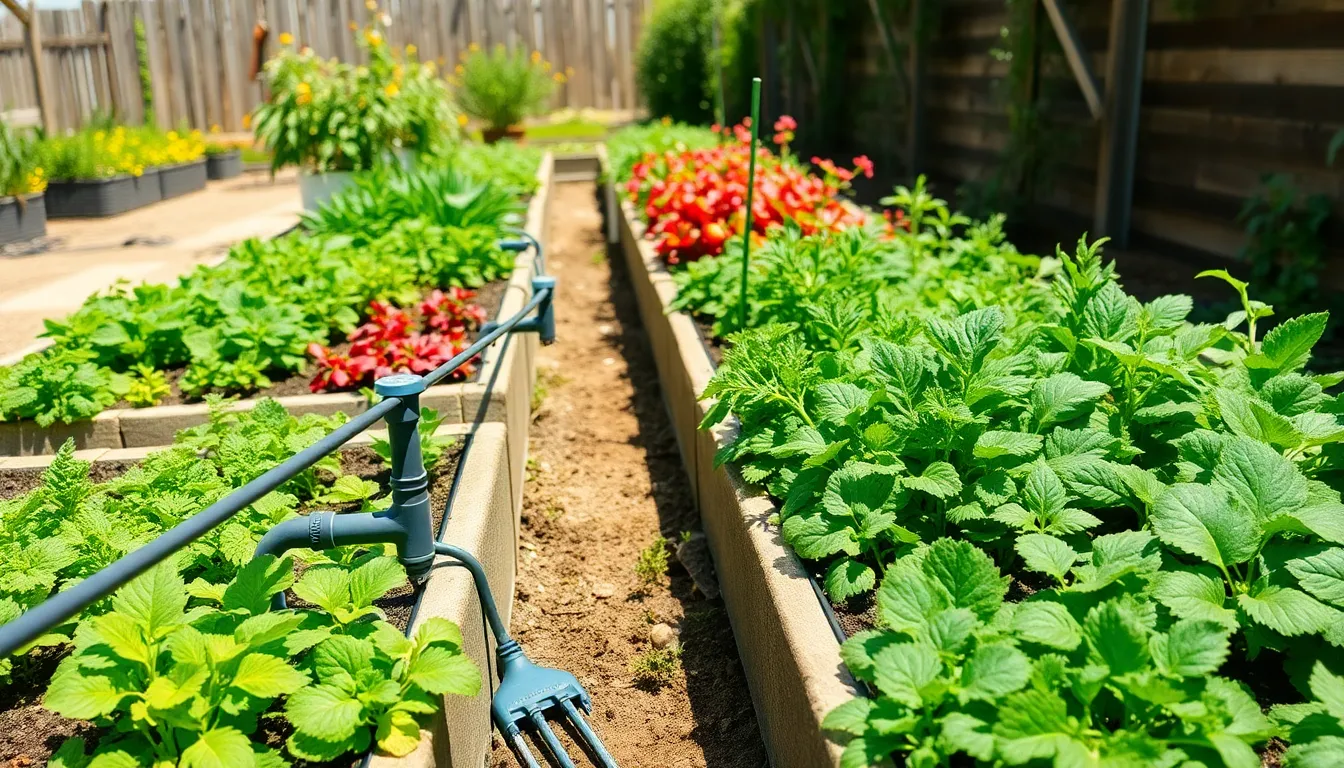
Water management forms the foundation of successful kitchen garden productivity. We’ll transform our growing spaces into thriving ecosystems that deliver consistent moisture while protecting plant roots from waterlogged conditions.
Set Up Drip Irrigation for Consistent Moisture
Drip irrigation systems deliver water directly to plant roots while minimizing waste and preventing foliage diseases. We recommend installing automated timers or soil moisture sensors to maintain optimal growing conditions without constant manual monitoring. These systems provide steady moisture levels that promote healthy root development and reduce water consumption by up to 50% compared to traditional watering methods.
Position drip emitters 6-12 inches apart along planting rows to ensure even coverage across all plants. We suggest using adjustable flow emitters for different plant types, allowing herbs to receive less water than thirsty vegetables like tomatoes and peppers. Connecting the system to a timer creates hands-off convenience that maintains consistent moisture even during busy schedules or travel periods.
Pressure compensating emitters work best for sloped garden areas, delivering uniform water flow regardless of elevation changes. We find that running the system for 15-30 minutes daily during growing season provides adequate moisture for most kitchen garden plants. Installing a filter at the water source prevents clogging and extends system lifespan significantly.
Ensure Proper Drainage to Prevent Root Rot
Proper drainage protects plants from waterlogging and root rot while maintaining healthy soil structure. We create drainage by drilling adequate holes in raised beds and containers, ensuring excess water can escape freely. Using well-draining soil mixes prevents water from pooling around sensitive root systems.
Fill raised beds with quality garden soil mixed with organic matter to improve drainage and fertility simultaneously. We recommend adding compost to heavy clay soils to create better drainage pathways and increase soil porosity. Avoiding compacted soil layers allows water to move through the growing medium naturally.
Installing drainage rocks or gravel at container bottoms creates additional water escape routes. We suggest elevating containers slightly off ground surfaces using pot feet or blocks to prevent standing water underneath. Testing drainage by watering thoroughly and observing how quickly excess water exits helps identify potential problem areas before planting.
Consider Indoor Growing Options for Year-Round Production
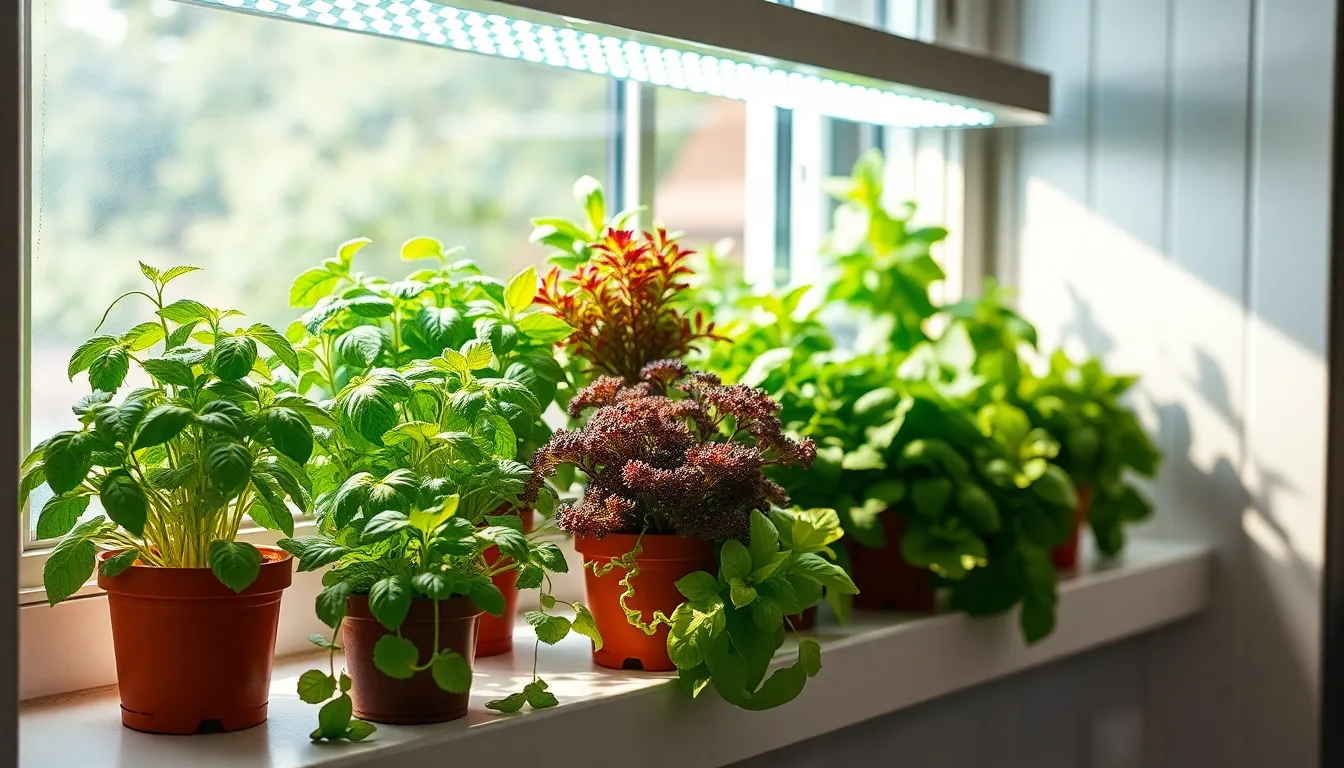
We can extend our kitchen garden season indefinitely by bringing plants indoors. Indoor growing lets us enjoy fresh herbs and vegetables even during harsh winter months.
Use Grow Lights for Winter Gardening
LED grow lights transform any indoor space into a productive growing area for our kitchen garden plants. Most vegetables and herbs need at least 12 hours of light daily to thrive, making artificial lighting essential during winter months or in low light areas.
Setting up grow lights requires positioning them 6-12 inches above our plants and adjusting height as they grow. We should choose full spectrum LED lights that consume less energy while providing optimal growing conditions for our indoor crops.
Selecting the right plants maximizes our success with artificial lighting systems. Lettuce, kale, and spinach perform exceptionally well under grow lights, producing tender leaves throughout winter. These leafy greens adapt quickly to indoor conditions and provide continuous harvests for our kitchen needs.
Select Windowsill-Friendly Varieties
Sunny windowsills offer perfect growing spots for compact herbs that enhance our cooking year round. Basil and chives thrive on windowsills with direct sunlight, allowing us to harvest fresh leaves daily for our meals.
Cherry tomatoes bring summer flavors indoors when we choose dwarf varieties designed for container growing. These compact plants need sunny windowsills and small trellises for support, producing sweet tomatoes throughout winter months.
Leafy greens like lettuce, kale, and arugula make excellent windowsill choices since they require minimal space and tolerate partial shade conditions. We can harvest outer leaves while allowing centers to continue growing, ensuring steady supplies of fresh salad ingredients.
Microgreens offer the highest nutrition density in the smallest growing space, making them ideal for kitchen windowsills. These nutrient rich seedlings grow quickly in shallow containers and provide intense flavors for garnishing our dishes.
Sprouts require no soil or special equipment, growing successfully in mason jars on any kitchen counter. We can produce fresh sprouts for salads within days, making them perfect for continuous indoor growing throughout winter.
Conclusion
We’ve covered many approaches to transform any space into a thriving kitchen garden that’ll enhance your cooking and reduce grocery costs. From simple herb containers on windowsills to sophisticated vertical growing systems these strategies work for beginners and experienced gardeners alike.
The key lies in starting small and expanding gradually as you gain confidence. Whether you choose fast-growing leafy greens succession planting techniques or indoor growing setups during winter months each method we’ve discussed can provide fresh produce year-round.
Your kitchen garden journey doesn’t require perfection from day one. Pick one or two ideas that match your available space and time commitment then build from there. Soon you’ll discover the satisfaction of harvesting homegrown herbs and vegetables that’ll elevate every meal you prepare.
Frequently Asked Questions
What is a kitchen garden and why should I start one?
A kitchen garden is a home-based growing space where you cultivate fresh herbs, vegetables, and other edibles for cooking. It provides fresher, more nutritious produce than store-bought options while saving money on groceries. Kitchen gardens also reduce your environmental impact, connect you with nature, and inspire culinary creativity. Anyone can start one regardless of space or experience level.
Which herbs are best for beginners to grow in a kitchen garden?
Start with easy-to-grow herbs like basil, parsley, cilantro, and chives. Sweet basil varieties like Genovese are particularly versatile and low-maintenance. Parsley provides continuous harvests, while cilantro grows quickly in cool weather. Chives are virtually indestructible and regrow after cutting. These herbs require minimal care while adding maximum flavor to your cooking.
How can I maximize growing space in a small kitchen garden?
Use vertical growing solutions like wall-mounted planters, living walls, and window boxes with trellises. Create tiered garden beds using shelving systems or repurpose items like ladders and shoe organizers. Hanging planters and wood pallet gardens also efficiently utilize vertical space. These methods allow you to grow more plants in limited square footage while maintaining easy access.
What are the fastest-growing vegetables for quick harvests?
Leafy greens like lettuce and spinach mature in 20-50 days, while radishes are ready in just 21-30 days. Green onions provide continuous harvests and regrow quickly after cutting. These vegetables require minimal space and care, making them perfect for beginners. Practice succession planting every 2-3 weeks to ensure a continuous supply throughout the growing season.
What containers work best for different vegetables?
Use large pots (at least 5 gallons) for tomatoes and peppers to support their extensive root systems. Root vegetables like carrots and beets need containers 6-8 inches deep, while radishes thrive in 4-6 inches. Ensure all containers have proper drainage holes. Container gardening offers mobility and better soil control compared to traditional ground planting.
How does companion planting benefit kitchen gardens?
Companion planting pairs complementary plants to maximize productivity and naturally deter pests. Basil enhances tomato growth and flavor, while marigolds repel harmful insects. The Three Sisters method (corn, beans, squash) maximizes yield in minimal space. Strategic interplanting of fast-growing crops with slower ones, like radishes with carrots, efficiently uses garden space.
What watering methods work best for kitchen gardens?
Install drip irrigation systems to deliver consistent moisture directly to plant roots while minimizing water waste and preventing leaf diseases. Use automated timers or soil moisture sensors to maintain optimal watering conditions. Ensure proper drainage in all containers and raised beds to prevent root rot and promote healthy plant growth.
Can I grow kitchen garden plants indoors year-round?
Yes, use LED grow lights to provide necessary light for indoor plants during winter months. Choose compact varieties like dwarf cherry tomatoes, basil, and chives for windowsill growing. Leafy greens and microgreens grow quickly indoors with minimal space requirements. Sprouts can be easily grown in mason jars without soil or special equipment.

